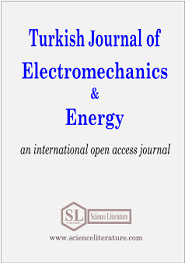
The Measurement of the Efficiency of Wind Power Plants by Using DEA: A Case Study from TURKEY
Abstract
Energy is an important sector with great investments and strategic importance. Wind power plants (WPPs) have the most in-demand from the capacity of renewable energy sources in Turkey, where licensing, installation and commissioning processes can be performed relatively easily. According to the Republic of Turkey’s Ministry of Energy and Natural Resources, the installed capacity of Turkey as of mid-2019 is 90.421 MW. The distribution of this installed capacity was obtained from various resources: 31.4% hydraulic energy, 29.0% natural gas, 22.4% coal, 8.0% wind, 6.0% solar, 1.5% geothermal and 1.7% from other sources. Efficiency studies on wind energy are important for directing investments correctly and evaluating national wealth. By increasing the efficiency of existing facilities, more electrical energy will be produced, and the average number of people whose energy demand are met will increase. This study aimed to determine the effectiveness of the existing 99 WPPs in Turkey, using the Data Envelopment Analysis (DEA) method. In this way, instead of investing in a new WPP, factors that contribute to ineffectiveness can be discussed by identifying inactive facilities. The efficiencies of WPPs were calculated using input-oriented CCR (Charnes, Cooper and Rhodes) and BCC (Banker, Charnes, Cooper) DEA models. The model results were compared, and the effectiveness of WPPs was investigated. The results revealed that only six plants were relatively effective according to the CCR model, while 18 plants were relatively effective according to the BCC model
References
YEGM (Yenilenebilir Enerji Genel Müdürlüğü), http://www.yegm.gov.tr/yenilenebilir/ruzgar-ruzgar_enerjisi.aspx,[accessed 10.04.2019], (2019).
Enerji ve Tabi Kaynaklar Bakanlığı (ETKB), https://www.enerji.gov.tr/tr-TR/Sayfalar/Ruzgar, [accessed 10.04.2019], (2019).
Tureb,https://www.tureb.com.tr/files/bilgi_bankasi/turkiye_res_durumu/istatistik_raporu_temmuz_2019.pdf, [accessed 10.04.2019], (2019).
M. Aykırı, Enerjide Dışa Bağımlılık ve Sağlıklı Büyüme: Türkiye Örneği, Aydın İktisat Fakültesi Dergisi, 3(2), 50-67, (2018).
M. Ömürgülşen, E. Tamer, K.B. Atıcı, Türkiye'deki Rüzgâr Enerjisi Santrallerinin Göreli Etkinliklerinin Veri Zarflama Analizi ile Ölçümü, Hacettepe Üniversitesi İktisadi ve İdari Bilimler Fakültesi Dergisi, 34(2), (2016).
Ü. Kaya, Y. Oğuz, Ü. Şenol, An Assessment of Energy Production Capacity of Amasra Town Using Artificial Neural Networks, Turkish Journal of Electromechanics and Energy, 3(1), 22-26, (2018).
D. Rekioua, F. Zaouche, H. Hassani, T. Rekioua, S. Bacha, Modeling and fuzzy logic control of a stand-alone photovoltaic system with battery storage, Turkish Journal of Electromechanics and Energy, 4(1), 11-17, (2019).
M.S. Ebrahim, A. M. Sharaf, A. M. Atalla, A. S. Emarah, Modified P&O Technique for Hybrid PV-Battery Smart Grid Integrated Scheme, Turkish Journal of Electromechanics and Energy, 3(2), 1-7, (2018).
Z. Mokrani, D. Rekioua, T. Rekioua, Control of Fuel Cells-Electric Vehicle Based on Direct Torque Control, Turkish Journal of Electromechanics and Energy, 3(2), 8-14, (2018).
E. Özşahin, Ç. Kaymaz, Rüzgâr Enerji Santrallerinin (Res) Kuruluş Yeri Seçiminin CBS İle Analizi: Hatay Örneği, TÜBAV Bilim Dergisi, 6(2), 1-18, (2013).
G. Can, M. A. Yücel, Coğrafi Bilgi Sistemleri ve Analitik Hiyerarşi Prosesi Kullanarak Rüzgar Enerji Santralleri İçin Yer Tespiti, 17. Türkiye Harita Bilimsel ve Teknik Kurultayı, 25-27 Nisan 2019, Ankara.
N. N. Özön, İ. Kılıçaslan, Kocaeli İlinde Rüzgar Çiftliği için Yer Seçimi, EMO Dergisi, (2007).
F. Taraf, H. R. Yazgan. Jeotermal ve Rüzgar Enerjisi Santrallerinde Yer Seçimi Probleminin Analitik Ağ Süreci ile Çözülmesi, Anka E-Dergi, 3(2), 42-55, (2018).
A. Sözen, A. Mirzapour, M. T. Cakır, Ü. İskender, F. Çipil, Selecting best location of wind plants using DEA and TOPSIS approach in Turkish cities. Gazi J Eng Sci, 1(1), 173-193, (2015).
F. Köse, M, Özgören, Rüzgar enerjisi potansiyeli ölçümü ve rüzgar türbini seçimi, Mühendis ve Makine, Vol. 551, 20-30, (2005).
A. Sarucan, M. C. Akkoyunlu, B. A. Ş Aydoğan, Analitik Hiyerarşi Proses Yöntemi İle Rüzgâr Türbin Seçimi, Selçuk Üniversitesi Mühendislik. Bilim ve Teknoloji Dergisi, 25(1), 11-18, (2010).
E. Dikmen, F. K. Örgen, Ağlasun Bölgesi için Rüzgâr Hızı Tahmini ve En Uygun Türbin Tespiti, Ömer Halisdemir Üniversitesi Mühendislik Bilimleri Dergisi, 7(2), 871-879, (2018).
A. Özdamar, Farklı Anma Güçlü Rüzgar Türbinlerinin Çeşitli Kriterlere Göre Karşılaştırılması, Pamukkale Üniversitesi Mühendislik Bilimleri Dergisi, 7(1), 17-27, (2011).
A. Sedaghat, F. Alkhatib, A. Eilaghi, M. Sabati, L. Borvayeh, A. Mostafaeipour, A new strategy for wind turbine selection using optimization based on rated wind speed, Energy Procedia, Vol. 160, 582-589, (2019).
Ö. Doğancı, M. Ertürk, A. Özsunar, E. Arcaklıoğlu, Orta ve Batı Karadeniz Bölgesi Rüzgâr Enerjisi Tahmin Çalışması, İleri Teknoloji Bilimleri Dergisi, 5(1), (2016).
N. Korprasertsak, T. Leephakpreeda, Robust short-term prediction of wind power generation under uncertainty via statistical interpretation of multiple forecasting models, Energy, Vol.180, 387-397, (2019).
Y. Hao, L. Dong, X. Liao, J. Liang, L. Wang, B. Wang, A novel clustering algorithm based on mathematical morphology for wind power generation prediction, Renewable energy, Vol. 136, 572-585, (2019).
T. Mahmoud, Z.Y. Dong, J. Ma, An advanced approach for optimal wind power generation prediction intervals by using self-adaptive evolutionary extreme learning machine, Renewable energy, Vol. 126, 254-269, (2018).
N. N. Esfetang, R. Kazemzadeh, A novel hybrid technique for prediction of electric power generation in wind farms based on WIPSO, neural network and wavelet transform, Energy, Vol. 149, 662-674, (2018).
Ü. Sağlam, A two-stage performance assessment of utility-scale wind farms in Texas using data envelopment analysis and Tobit models, Journal of Cleaner Production, Vol. 201, 580-598, (2018).
Ü. Sağlam, A two-stage data envelopment analysis model for efficiency assessments of 39 state’s wind power in the United States, Energy Conversion and Management, Vol. 146, 52-67, (2017).
Ü. Sağlam, Assessment of the productive efficiency of large wind farms in the United States: an application of two-stage data envelopment analysis, Energy Conversion and Management, Vol. 153, 188-214, (2017).
Y. Wu, Y. Hu, X. Xiao, C. Mao, Efficiency assessment of wind farms in China using two-stage data envelopment analysis, Energy Conversion and Management, Vol. 123, 46-55, (2016).
Y. Eroğlu, S. U. Seçkiner, Performance analysis in wind farms by data envelopment analysis and Malmquist Index approaches, Pamukkale University Journal of Engineering Sciences, 23(1), 45-54, (2017).
E. T. Emre, M. Ömürgönülşen, Marmara Bölgesi’ndeki Rüzgâr Elektrik Santrallerinin (RES) Göreli Etkinliklerinin Veri Zarflama Analizi (VZA) ile Ölçümü. Verimlilik Dergisi, Vol. 4, 7-32, (2013).
K. Sarıca, I. Or, Efficiency assessment of Turkish power plants using data envelopment analysis, Energy, 32(8), 1484-1499, (2007).
M. J. Farrell, The measurement of productive efficiency, Journal of the Royal Statistical Society: Series A (General), 120(3), 253-281, (1957).
A. Charnes, W. W. Cooper, E. Rhodes, Measuring the efficiency of decision making units, European journal of operational research, 2(6), 429-444, (1978).
R. D. Banker, A. Charnes, W. W. Cooper, Some Models for Estimating Technical and Scale Inefficiencies in Data Envelopment Analysis, Management Science, 30(9), 1078-1092, (1984).
A. Özbek, Çok Kriterli Karar Verme Yöntemleri ve Excel İle Problem Çözümleri, Seçkin Yayıncılık, Ankara, (2017).
Ü. Özden, Veri zarflama analizi (VZA) ile Türkiye'deki vakıf üniversitelerinin etkinliğinin ölçülmesi, İstanbul Üniversitesi İşletme Fakültesi Dergisi, 37(2), 167-185, (2008).
Energy Atlas, https://www.enerjiatlasi.com/ruzgar/, [accessed 10.04.2019], (2019).
URN: https://sloi.org/urn:sl:tjoee42145
Copyright (c) 2019 Turkish Journal of Electromechanics and Energy

This work is licensed under a Creative Commons Attribution-NonCommercial 4.0 International License.

 Indexed in:
Indexed in:
















